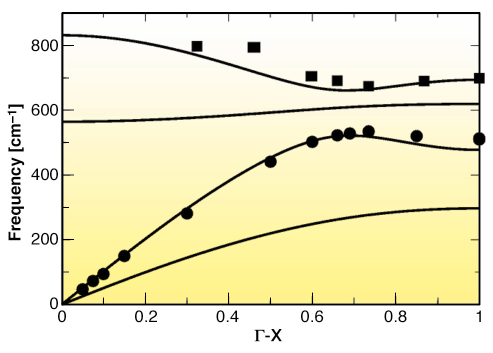- Home
- Users & Science
- Scientific Documentation
- ESRF Highlights
- ESRF Highlights 2005
- High Resolution and Resonance Scattering
- Lattice Dynamics of MgO at High Pressure: Theory and Experiment
Lattice Dynamics of MgO at High Pressure: Theory and Experiment
The experimental determination of the phonon dispersion at high pressure constitutes an important ingredient for the characterisation of the physical properties of materials at extreme conditions. It gives access to valuable quantitative information concerning elasticity, thermodynamic properties, and the dynamics of phase instabilities. Furthermore, the experimental data provide important tests for the accuracy of theoretical lattice dynamical models. Among these the most advanced ones are ab initio quantum mechanical calculations, using density functional perturbation theory. Critical inputs are the appropriate choice of the potential (all-electron or pseudopotential approaches) and the correct description of the exchange-correlation term. If a good agreement with the experimental phonon dispersion is observed, these calculations can then be used with increased confidence to describe the physical properties at very high pressures beyond the reach of current experimental methods.
Here we present experimental and theoretical results on MgO, a prototype oxide due to its simple structure and the large stability field (in pressure and temperature) of the NaCl structure. MgO is furthermore an important ceramic for industrial applications, and of great interest for Earth sciences, since it is a major mineral phase of the Earth’s lower mantle. A doubly polished single crystal of MgO of (100) orientation, 30 x 50 µm size and a thickness of 20 µm was loaded in a diamond-anvil cell with He as pressure transmitting medium. The IXS experiment was performed on beamline ID28 with an overall energy resolution of 3 meV. Theoretical phonon dispersion curves were calculated using density-functional perturbation theory using the pseudopotential plane wave code ABINIT [1]. Details on the calculations can be found elsewhere [2].
Figure 17 shows the accordance between the two longitudinal phonon branches, acoustic and optic, measured along the ![]() – X direction at 35 GPa with those calculated by ab initio methods. The fact that characteristic features in the phonon dispersion are well reproduced by calculations gives confidence that ab initio predictions of thermodynamic properties of MgO at high pressure will be accurate. The determination of a thermodynamic property at high pressure requires experimental determination of the thermal expansion and bulk modulus, which are recast into an equation of state (EOS). Such EOS data are very few and when available, the data usually requires large extrapolation. Thermodynamic properties at high pressure may be calculated from a combination of calorimetric data at 1 bar and the volume integral with changing pressure and temperature [3]. Using the available thermodynamic data we obtain CV = 30 (+/-5) and
– X direction at 35 GPa with those calculated by ab initio methods. The fact that characteristic features in the phonon dispersion are well reproduced by calculations gives confidence that ab initio predictions of thermodynamic properties of MgO at high pressure will be accurate. The determination of a thermodynamic property at high pressure requires experimental determination of the thermal expansion and bulk modulus, which are recast into an equation of state (EOS). Such EOS data are very few and when available, the data usually requires large extrapolation. Thermodynamic properties at high pressure may be calculated from a combination of calorimetric data at 1 bar and the volume integral with changing pressure and temperature [3]. Using the available thermodynamic data we obtain CV = 30 (+/-5) and ![]() S = 20.68 (+/-1) Jmol-1K-1. From the calculated phonon density-of-states at 35 GPa we determine CV = 31.71 and S = 20.04 Jmol-1K-1. The two data sets match within the errors of experimental data.
S = 20.68 (+/-1) Jmol-1K-1. From the calculated phonon density-of-states at 35 GPa we determine CV = 31.71 and S = 20.04 Jmol-1K-1. The two data sets match within the errors of experimental data.
 |
|
Fig. 17: Phonon dispersion of MgO along the |
In summary, we demonstrate the ability of modern theory to reproduce experimental data on lattice dynamics of an inorganic compound at very high pressure. Expanding such tests to other, more complex systems could be beneficial for the development of both theory and experiment. These tests, validating the approximations done in the calculations, will allow the reliable determination of the thermodynamic properties of materials at high pressure, which are otherwise extremely difficult to assess by experimental methods.
References
1] X. Gonze et al.; Comp. Mater. Sci. 25, 478 (2002).
[2] A.R. Oganov, M.J. Gillan, and G.D. Price; J. Chem. Phys. 118, 10174 (2003).
[3] S.K. Saxena, N. Chatterjee, Y. Fei and G. Shen in Thermodynamic data on oxides and silicates; Springer Verlag, Berlin, 428 p (1993).
Principal Publication and Authors
S. Ghose (a), M. Krisch (b), A.R. Oganov (c), A. Beraud (b), A. Bossak (b), R. Gulve (d), R. Seelaboyina (d), H. Yang (d) and S.K. Saxena (d), accepted in Phys. Rev. Lett.
(a) Mineral Physics Group, University of Washington, Seattle (USA)
(b) ESRF
(c) Laboratory of Crystallography, Department of Materials, E.T.H., Zurich (Switzerland)
(d) Center for Study of Matter at Extreme Conditions, Florida International University Park, Miami (USA)



